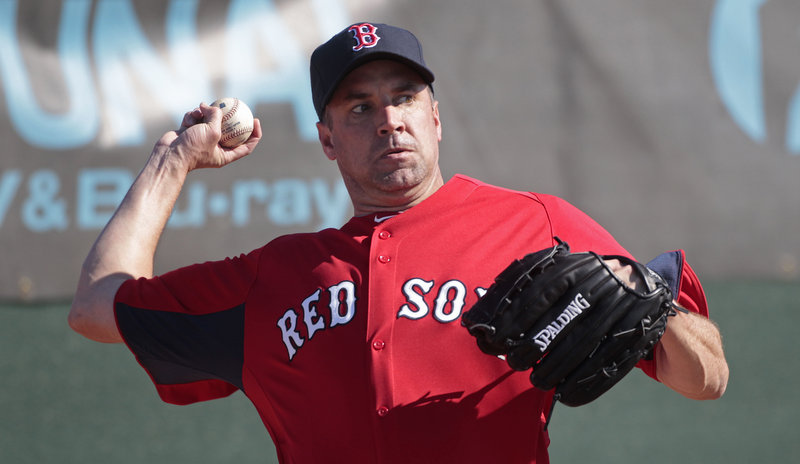FORT MYERS, Fla. – Scott Atchison returned from Japan so his daughter could get better treatment for a rare medical condition. He found a major-league job as a bonus.
Now he’s trying to show the Boston Red Sox he can throw well enough to be part of their bullpen for a second straight season.
And he takes pride in the fact that Callie, who turned 3 in October, has worked hard to throw a ball herself, even though she has no radius bone in either forearm and both arms are considerably shorter than normal.
“She’s left-handed,” Atchison said. “She picks it up and she’ll fire it pretty good.”
Atchison, a 34-year-old right-hander, has come a very long way — professionally, geographically and emotionally — since the Seattle Mariners drafted him in the 49th round in 1998, hardly a spot for a can’t-miss prospect. That followed rotator cuff surgery while at Texas Christian that nearly ended his career before he left college.
Atchison didn’t reach the majors until 2004, when he went 2-3 with a 3.52 ERA in 25 relief outings with Seattle. He spent most of the next season in the minors, pitching just six games with the Mariners, and didn’t return to the majors until 2007, when he appeared in 22 games with the San Francisco Giants, posting a 4.11 ERA and 0-0 record.
The Red Sox signed him to a minor- league contract on Dec. 7, 2007, but released him two weeks later.
By that time he was already 31. Callie, his only child, was born on Oct. 23, 2007. It was time to take a long look at his family’s future.
The Hanshin Tigers were offering a guaranteed contract. He and his wife, Sarah, thought a lot and he agreed to it in early January 2008.
Before leaving, Callie received transfusions for a low blood platelet count, part of the rare genetic disorder called thrombocytopenia-absent radius, and had her blood counts monitored in Japan. A low platelet count can inhibit the blood’s ability to clot.
That was “the biggest concern her first year,” said Atchison, soft-spoken and humble. “We needed to get her platelets checked once every two months at that point and (Hanshin) set us up so we could get it done.”
He had two strong seasons there, going 12-9 with a 2.77 ERA in 117 outings, 12 as a starter.
That attracted the attention of the Red Sox. When Atchison returned to the United States so Callie could have improved access to medical care, he signed with Boston. But Atchison still had to make the team last year and did it with an impressive spring training.
He began the season with Boston, spent time at Triple-A Pawtucket and finished the year with a 2-3 record and 4.50 ERA in 43 games, including one emergency start.
“He can pitch in any role,” Manager Terry Francona said. “He was very valuable to our bullpen.”
That might not have happened if Callie had been born with normal arms that didn’t require the care available in the United States.
Callie also has short ulna bones that end just below each elbow. As a result, her wrists lack support and her thumbs have little strength.
In January 2010, about a month before Atchison went to spring training, an operation helped straighten her right hand.
“The big thing is trying to get her to be able to use her thumbs because of the way her hands are set,” Atchison said. “She does pretty much anything every normal kid would do. She’s progressed a ton. She’s nonstop, like any 3-year-old.”
Earlier this month, Callie ran around the Red Sox camp, just like any other kid.
Now Atchison is focusing on his own challenge, sticking with the Red Sox after they added Bobby Jenks and Dan Wheeler to help Jonathan Papelbon and Daniel Bard in the bullpen with the third-worst ERA in the AL last season. More than a half-dozen relievers are competing for the two remaining spots.
Copy the Story Link
Send questions/comments to the editors.



Success. Please wait for the page to reload. If the page does not reload within 5 seconds, please refresh the page.
Enter your email and password to access comments.
Hi, to comment on stories you must . This profile is in addition to your subscription and website login.
Already have a commenting profile? .
Invalid username/password.
Please check your email to confirm and complete your registration.
Only subscribers are eligible to post comments. Please subscribe or login first for digital access. Here’s why.
Use the form below to reset your password. When you've submitted your account email, we will send an email with a reset code.